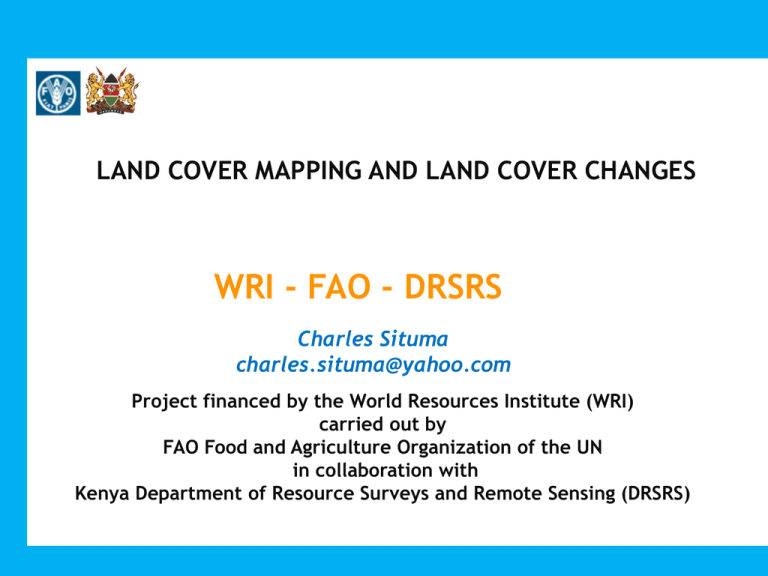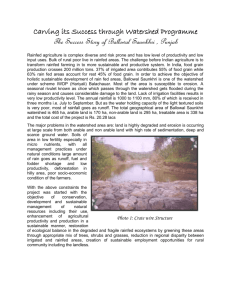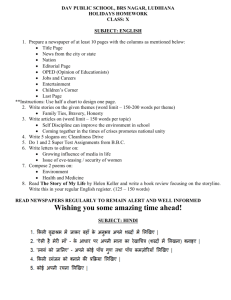Agriculture
advertisement

LAND COVER MAPPING AND LAND COVER CHANGES WRI - FAO - DRSRS Charles Situma charles.situma@yahoo.com Project financed by the World Resources Institute (WRI) carried out by FAO Food and Agriculture Organization of the UN in collaboration with Kenya Department of Resource Surveys and Remote Sensing (DRSRS) DEPARTMENT OF RESOURCE SURVEYS AND REMOTE SENSING (DRSRS) MANDATE Collection, storage, analysis, updating and dissemination of geospatial information on natural resources and environment to facilitate informed decision-making for sustainable development The data collected by the department forms the basis for formulation of sound development plans, policies and strategies various government ministries and agencies. DRSRS strives to meet objectives and aspirations of the Ministry and GoK as outlined in Vision 2030 Publications Project purposes: - Update of Kenya land cover map (FAO Africover database) 2000 - 2010 - Land Cover Changes Analysis DELIVERABLES - National harmonized land cover legend based on FAO/UNEP Land Cover Classification System (LCCS) - National Land Cover Database - National Land Cover Changes database (shapefile and mdb) PRODUCT DISSEMINATION -The data is hosted by DRSRS - Results could be downloaded through FAO’s geospatial data portal GeoNetwork Satellite image interpretation for land cover mapping Land Cover update - Workflow • Satellite - Images acquisition • Object based segmentation – Definiens Ecognition Software • Legend - based on FAO Land Cover Classification System / Africover • Prelabeling of images based on former FAO Africover Data • Interpretation detail enhancement new tools for classification and labeling FAO Madcat Software • Fieldwork Activities • Topology check • Interpretation review based on field work results • Review of homogenity and consistency of interpretation between photointerpreters • Review of Database fields and codes • GIS review – final topology check • Final database output – Data overview through FAO ADG Software 1) Satellite images Landsat (2000) Landsat (2005) Landsat Aster Aster Google Earth Google Earth Overview Landsat image index Overview Aster image index FIELDWORK ACTIVITIES A fieldwork campaign was carried out in March 2011. Areas to be surveyed were defined following a regular grid of 0.5 degrees 10*10 Km (ECONET) According with the accessibility of the areas (security issues, road network, time schedule) were defined 1 to 4 land cover classes to survey for each area. If the plot could not be reached, the points were selected out of the box in nearby areas. The map shows the points for each one of the 3 fieldwork teams with additional points within the 10 km plots. (Source: DRSRS Final Report on Fieldwork Activities) A sample field data record sheet filled in the field during survey –MDB format The total points visited by the 3 groups are as follows, Group1 : 60 points Group2: 84 points Group3: 50 points. Sample point selection The FAO Afrocover methodology for land cover field survey was illustrated in the last 2 days of the workshop held in DRSRS in January 2011. Due to the fact that the preliminary interpretation was not yet completed was defined to use a regular grid as source to define the field points, as mentioned in the previous slide. Within this areas, according with the accessibility and land cover type available in the area, were defined specific locations to survey (1-4 points for each block). Each sample plot measured 10 Km x10 Km Figure 3.2). At least three sample points were surveyed in each plot The full procedure was run from the accessibility assessment, to the definition of field work results output. 10 Km 10 Km Sampling area Sample point Field Survey Survey KE_167 KE_167 Field Picturedirection directionW S Picture For Each poin were recorded information about the land cover and 4 pictures in the cardinal directions N E S W The survey number and picture direction are visible in the blackboard in the picture After the field work, the data was downloaded and loaded in ArcGIS with all the details of each plot no and corresponding photos of each plot. An hyperlink was created in order to view the pictures linked to each point clicking on the point symbol Map Code Class User Name LCCS Gis Code A11 - Cultivated and managed terrestrial areas Legend LCCS Class Name Broadleaved evergreen forest plantation Needleleaved evergreen forest plantation Permanently cropped area with rainfed tree crops. Large sized fields (> 4 ha) Citrus plantation. Surface Irrigated Small sized fields (<2ha) of rainfed tree crops Scattered Isolated small fields (<2ha) of rainfed tree crops Large to medium (>2ha) sized rainfed shrub crops. Large to medium (>2ha) sized rainfed shrub crops. Pineapple Large to medium (>2ha) sized rainfed shrub crops. Coffee Large to medium (>2ha) sized rainfed shrub crops. Tea Large to medium (>2ha) sized rainfed shrub crops. Sisal Small (<2ha) rainfed shrub crops Scattered Isolated small (<2ha) rainfed shrub crops Large to medium (>2ha) rainfed herbaceous crops Large to medium (>2ha) rainfed herbaceous crops. Cereals Large to medium (>2ha) irrigated herbaceous crops. Large to medium (>2ha) irrigated herbaceous crops. Sugar cane Scattered isolated large to medium (>2ha) rainfed herbaceous crops 1TPLbe 10153-1-W7 1TPLne 10153-5671-W7 1TLPL 10495-11341-W7 1TLMi_ci 10499-1888-S0606W8 1TS 10541-W8 1TS-is 10557-W8 1SLM 10567 1SLM_p 10567-S0619 1SLM_co 10567-S0802 1SLM_t 10567-S0804 1SLM_s 10567-S0913 1SS 10613 1SS-is 10629 1HLM 10637 1HLM_ce 10637-S3 1HLMi 10651 1HLMi_su 10651-13227-S0915 1HLM-is 10717 1HLM-is_ce 10717-S3 1HS 10756 Scattered isolated large to medium (>2ha) rainfed herbaceous crops. Cereals Small (<2ha) fields of rainfed herbaceous crops. Small (<2ha) fields of rainfed herbaceous crops. Second layer: sparse trees 1HS+2TS 10285 + 20053 1HSS+2TS 10756-L2 + 20052 1HS_ce 10756-S3 1HSY 10760 1HSi 10763 Small (<2ha) fields of rainfed herbaceous crops on sloping land. Second layer: sparse trees Small (<2ha) fields of rainfed herbaceous crops. Cereals Small (<2ha) fields of post flooding herbaceous crops Small (<2ha) fields of irrigated herbaceous crops. Scattered isolated small (<2ha) fields of rainfed herbaceous crops Scattered isolated small (<2ha) fields of rainfed herbaceous crops. Cereals Scattered Isolated Small (<2ha) fields of post flooding herbaceous crops Greenhouse 1HS-is 10796 1HS-is_ce 10796-S3 1HSY-is 10800 1GH 11438-11971(2)[Z4] 70 classes A12 – Natural or semi-natural terrestrial vegetation Class User Name Map Code LCCS Gis Code 2TC 20282 LCCS Class Name Tree closed (>65%) Closed (>65%) broadleaved evergreen forest Closed (>65%) bamboo forest Trees open (40-65%) with shrubs closed to open (15-65%). Trees very open (15-40%) with shrubs closed to open (15-65%). Trees very open (15-40%) with sparse (<15%) shrubs Sparse Trees (< 15%) on sparse (<15%) herbaceous Closed (>65%) shrubs Open (40-65%) shrubs Very open (15-40%) shrubs Very open (15%-40%) shrubs with sparse (<15%) trees Sparse (<15%) shrubs Closed to Open (15-100%) herbaceous Closed to open (15-100%) herbaceous with sparse (<15%) trees Sparse (<15%) herbaceous 2TCbe 20634 2TCba 20282-Zt2 2TO_sco 20326-1 2TVO_sco 20326-3012 2TVO_ss 20336-3012 2TS 20505 2SC 20357 2SO 20385-1 2SVO 20385-3012 2SVOTS 20393-3012 2SS 20511 2HCO 21644 2HCOTS 21646 2HS 20060 Map Code LCCS Gis Code 3RLM 3030-S0308 3RS 3045-S0308 Map Code LCCS Gis Code 4TCFFbr 40040-R2 4TOF 40047 4SOF 40053 4SCOFF 41970 4HCOTSF 42175 4HCOFF 42347 4HCOF 42348 A23 – Cultivated aquatic or regularly flooded areas Class User Name LCCS Class Name Large to medium (>2ha) paddy rice fields Small(<2ha) paddy rice fields A24 – Natural or semi-natural aquatic vegetation Class User Name LCCS Class Name Closed (>65%) trees on permanently flooded land. Brackish water Open (15-65%) trees on temporarily flooded land Open (15-65%) shrubs on temporarily flooded land Closed to Open (15-100%) Shrubs On Permanently Flooded Land Closed to open (15-100%) herbaceous with sparse (<15%) trees on temporarily flooded land Closed to open (15-65%) herbaceous on permanently flooded land Closed to open (15-100%) herbaceous on temporarily flooded land B15 - Artificial surfaces and associates area(s) Class User Name Map Code LCCS Gis Code 5U 5003-9 5UR 5003-9-A44Zp1 5A 5003-A21 5UC 5003-A34 5Q 5004-2 Map Code LCCS Gis Code 6R 6002-1 6GR 6002-2 6S 6005 6L 6006 Map Code LCCS Gis Code 7WS 7002-5 Map Code LCCS Gis Code 8WFP 8002-1-V1 LCCS Class Name Urban areas Rural areas Airport Refugee camp Quarries B16 – Bare area(s) Class User Name LCCS Class Name Bare rock Gravels, Stones And/Or Boulders. River bank and rock debris Bare soil Loose sand B27 – Artificial water bodies, snow and ice Class User Name LCCS Class Name Artificial lake and pund B28 – Natural water bodies, snow and ice Class User Name LCCS Class Name Perennial rivers Perennial lakes Non-Perennial Natural Waterbodies (Flowing) with Scattered Vegetation Seasonal rivers Seasonal lakes Tidal area Perennial snow 8WSP 8002-5 8WFTv 8003-1-U1 8WFT 8003-4 8WST 8003-7 8Wt 8004-19 8SP 8006 KE_183_A KE_050_A KE_092_3 KE_092_3 KE_102_2 Land Cover Interpretation Kenya Land Cover Map Preliminary Results Overview Kenya LC database before field survey activity Results Overview Land Cover Data – National Level 1 Total Areas: 1970’s, 1980’s, 2000, 2010 2 Changes: area values - percentages Results Overview Forest, Agriculture, Urban areas Area Km2 Land cover type Results – Woody Coverage Overview: Spatial Distribution Kenya 2000 Tree closed, Tree open and Woody closed areas Results Closed forest coverage – Kenya Provinces Results Urban areas – Kenya Provinces Results Forest Plantations – Kenya Provinces Results – Agriculture a Agricultural Area Changes – Areal Distribution Of Changes a1) 1970’s - 2000 a2) 1970’s - 1980’s a3) 1980’s - 2000 b Agricultural Field Density b1) 1970’s b2) 1980’s b3) 2000 Results – Agriculture Agricultural Areas Km2 Agricultural areas – Kenya Provinces Results – Agriculture Agricultural field density 1970’s Kenya Land Cover Change analysis Agricultural areas The map shows the field density within the polygon area. According with LCCS in the agricultural fields classification there are 3 levels of spatial distribution: •Continuous fields •Scattered clustered •Scattered isolated Continuous fields cover > 80% of the polygon area when in single class codes and 50-80% when in mixed units Scattered clustered between 20 and 50% of the polygon area Scattered isolated between 10 and 20% of the polygon area Results – Agriculture Agricultural field density 1980’s Kenya Land Cover Change analysis Agricultural areas The map shows the field density within the polygon area. According with LCCS in the agricultural fields classification there are 3 levels of spatial distribution: •Continuous fields •Scattered clustered •Scattered isolated Continuous fields cover > 80% of the polygon area when in single class codes and 50-80% when in mixed units Scattered clustered between 20 and 50% of the polygon area Scattered isolated between 10 and 20% of the polygon area Results – Agriculture Agricultural field density 2000 Kenya Land Cover Change analysis Agricultural areas The map shows the field density within the polygon area. According with LCCS in the agricultural fields classification there are 3 levels of spatial distribution: •Continuous fields •Scattered clustered •Scattered isolated Continuous fields cover > 80% of the polygon area when in single class codes and 50-80% when in mixed units Scattered clustered between 20 and 50% of the polygon area Scattered isolated between 10 and 20% of the polygon area Results Overview Forest, Agriculture, Urban land cover area Area Km2 Land cover type Land Cover Changes 2000 - 2010 – Partial results TOTAL AREAS Agriculture Rangeland Trees Forest Plantation Urban Areas Water 2000 Ha 7242066 36518205 10601906 108461 82710 1463815 2010 Ha 7408341 36517633 10464454 98870 89294 1440852 % of change 2.3 0.0 -1.3 -8.8 8.0 -1.6 N.B. Total areas calculated considering the main class in mixed classes Dataset Applications Main fields of application: Planning (Land Use and Planning, Development Activities Planning) Education Research (Activities within Research Institutions and Universities) Water (Water Conservation, Use and Control) Agriculture (Soil and Land Conservation, Pest Control, Crop Monitoring) Environment (Forestry, Biodiversity, Wildlife, Sensitive Areas, etc.) Monitoring (Food Security, Early Warning) Health (Disease control, health infrastructure, vaccination campaigns, etc.) Other Application Database Request Statistics Relative Volumes of Data Set Requests by Application Other 14% Planning 18% Health 3% Monitoring 5% Education 8% Environment 17% Research 21% Agriculture 8% Water 6% % of requests per type of organization Universities 30% Governmental Organizations and Governmental Research Institutes 20% International NGOs 19% UN agencies and European Commission 19% Private and Commercial Organizations and Individuals 12% Total number of request for Kenya 2323 – pending 9 – rejected 219 Total number of delivered data for Kenya Total approved requests 2095 Kenya - Spatially Aggregated Multipurpose Landcover database (Africover) Kenya - Thematic Grassland Aggregation (Africover) Kenya - Thematic Agriculture Aggregation (Africover) Kenya - Thematic Woody Aggregation (Africover) Kenya - Thematic Aggregation Geomorphology / Lithology Kenya - Thematic Aggregation Geomorphology / Landform Kenya - Boundaries, Towns, Roads, Rivers 372 131 216 142 104 113 1017 Other Initiatives PASCO/KFS/RCMRD/DRSRS DRSRS is involved in: ◦ Clinton Climate Initiatives on land cover mapping of Kenya ◦ KFS REDD Readness plan for MRV (Monitoring, Reporting and Verification on Forests) ◦ FAO/DRSRS Dryland forest mapping for REDD THE END






